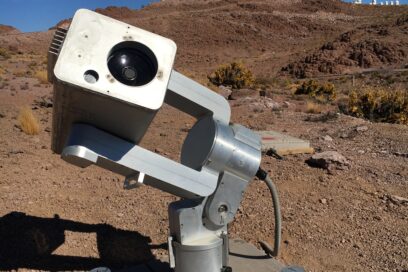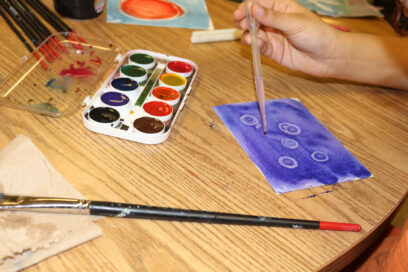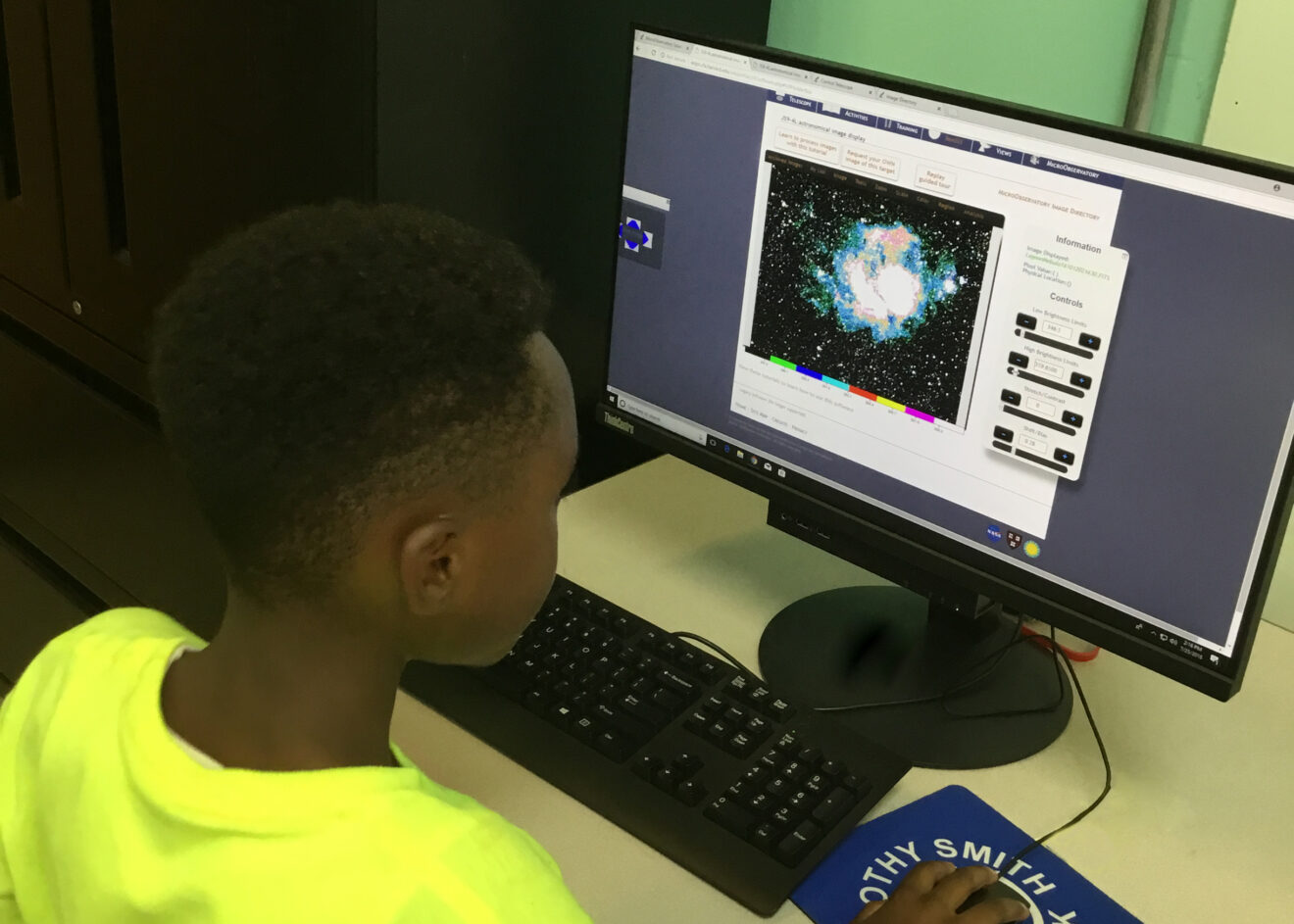What does it take to create a colorful image of the Lagoon Nebula? How do telescopes capture the incredible details in objects millions or even billions of light years away? What can we learn from a beautiful image of a spiral galaxy? These are just a few of the many questions we encourage learners to explore as we invite them on a journey to become an astronomical imager, or astrophotographer, at the Smithsonian Astrophysical Observatory, or SAO.
The night sky belongs to everyone, and for many people it inspires a deep sense of wonder. In the SAO’s Science Education Department, we aim to harness that wonder and shape it into a lifelong interest in science using our MicroObservatory Robotic Telescope Network. Learners of all ages can access these telescopes in the same way that SAO astronomers access NASA space observatories or many mountaintop telescope facilities — remotely using computer and digital communications technologies. Using our learner-friendly interfaces that have been designed for novice observers, anyone with an email address can request their very own images of the solar system, stars, galaxies and more.
While anyone can explore this process on their own using our free online MicroObservatory public portal, thousands of middle-school learners each year begin their journey to become astrophotographers through classroom, after-school and museum implementations of our YouthAstroNet program. The Youth Astronomy Network, or YouthAstroNet, is funded by the National Science Foundation’s Innovative Technology Experiences for Students and Teachers, or ITEST, program. YouthAstroNet shares ITEST’s mission to better understand how technology-rich experiences can promote student knowledge, interest and dispositions to pursue STEM careers, focusing especially on the equitable participation of groups underserved and underrepresented in these fields.
Building student science identity
YouthAstroNet is a national, online community of youth, educators, and scientists that aims to help youth gain confidence and identity as someone who can do science through personal participation in authentic inquiry, supported by unique access to the resources of the Center for Astrophysics | Harvard & Smithsonian. Our research has shown that science identity — the feeling of being a science person and being recognized by others as a science person — is an important ingredient in motivating young people to persist in STEM learning pathways. Our research also shows that astronomy can be a gateway to broader STEM interest.
YouthAstroNet participants start their journey by learning how to select astronomical targets to observe and how to choose telescope camera settings for field of view, exposure time and even wavelength of light through choice of color filters. Each request is placed in the network’s automated queue, and, that night, the telescopes hop into action to capture the image! The next day, participants receive their telescope images in their YouthAstroNet online account.
Just as is true for professionals, getting the raw telescope image data back is just the beginning of exploring the stories astronomical images tell. YouthAstroNet participants learn how to enhance, colorize and bring out the hidden details in their own digital images using the same image processing software and data visualization skills that are practiced by SAO scientists looking at Hubble or Chandra X-ray Observatory data. And just like scientists share the results of their work through talks and posters, all YouthAstroNet participants have the opportunity to participate in a capstone project to showcase the knowledge they’ve gained through the program — to show their friends, classmates, teachers, parents and community that they are science people!

YouthAstroNet in action
To ensure the program resonates with diverse audiences across the country, YouthAstroNet is customizable by our educators. That means no two YouthAstroNet programs will look exactly alike. But they all adhere to the same essential elements and core principles, which YouthAstroNet educators learn through an introductory online professional learning course
YouthAstroNet’s Essential Elements include:
- MicroObservatory telescopes, which allow participants to control and request data from real robotic telescopes to ask and seek answers to their own questions.
- Sense-Making with image, providing an opportunity for participants to examine, manipulate and analyze digital images of astronomical objects.
- Capstone projects, in which youth work is aimed at the creation of one or more final product(s) of personal interest using their own images to answer a question or communicate an idea or story about the universe to a wider audience.
The three core principles of YouthAstroNet are aimed at supporting educators in productively adapting the YouthAstroNet curriculum materials to leverage the cultural capital and everyday knowledge of students, which can be especially beneficial to students from nondominant communities.
- The sky belongs to everyone. This core principle emphasizes that the curiosity and creativity inspired by big questions about humanity’s place in the universe should be universal experiences.
- Listen to student ideas. YouthAstroNet curriculum activities provide multiple opportunities to draw on students’ own ideas, questions, cultural identities and everyday experiences as important resources to make meaningful connections to the science content and to promote engaged learning.
- There are many ways to be a science person. This core principle makes explicit that our assumptions about what scientists do, who they are and how they work are often way too narrow, exacerbating disparities in STEM engagement. Through a library of profiles of STEM professionals and other activities, YouthAstroNet strives to expand students’ ideas about science careers and how they might participate in science and still be fully the person they want to be!
YouthAstroNet implementation models from across the country demonstrate how these essential elements and core principles empower educators to apply their expertise in adapting our materials to provide uniquely relevant astronomy-inspired learning experiences for their students.
In Pierre, S.D., for example, the South Dakota Discovery Center partners with local rural and tribal school districts to engage middle-school students in astrophotography projects through YouthAstroNet. For their capstone project, students had their astronomical images put on display at the Discovery Center. As they requested and processed their own images, these students in rural South Dakota also learned the many ways to be a scientist by meeting virtually and asking questions of scientists from the Center for Astrophysics.

At the Springfield Museum of Art in Springfield, Ohio, (a Smithsonian affiliate museum), learners across the community have had an interdisciplinary experience connecting art with science. Educators at the museum partnered with classroom teachers, community centers and even juvenile detention centers to encourage young people to explore astrophotography and other forms of science visualization, informed by the visual arts expertise of the museum. In their implementation of YouthAstroNet, students take and process their own images of the night sky, then reimagine their astrophotography using various media and fine arts techniques that they learn throughout the program.
In Boston, participants of the Timothy Smith Network of community technology centers have explored the universe in after-school programs and summer camps. Students in these programs explored astronomy projects of their own interest while gaining critical 21st-century technology skills, a key goal of the TSN. Every student in a TSN YouthAstroNet program has showcased their work and their new expertise via capstone projects, which have varied from special events to exhibits to virtual showcases. In some iterations of their programs, students have even gone as far as creating 3D prints of their images using the resources of the FabLab, a TSN makerspace.
Get involved
The Smithsonian Astrophysical Observatory is currently recruiting educators interested in bringing YouthAstroNet programs into their classrooms. Educators can fill out this application form to join the community and to support our research into effective program scale-up. While YouthAstroNet is designed for middle-school-age audiences, everyone can explore the wonders of the night sky with the Smithsonian. Visit the MicroObservatory’s homepage to learn about our other projects. From there, you can explore all our access portals, from DIY Planet Search, where you can join the search for other worlds, to the Observing With NASA portal, where you can request images of the night sky.
Those looking to dive deeper can explore these video tutorials to learn how to process and analyze images. Smithsonian Learning Lab collections are also available to help you learn more about the objects you might be imaging with the MicroObservatory telescopes.
